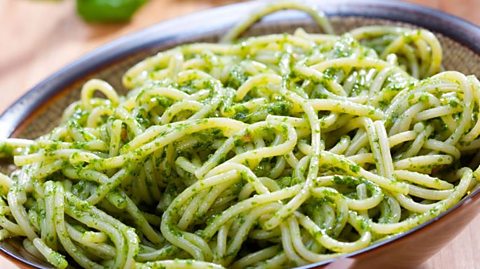Go-to source of fuel, quick-and-easy meal, or the ultimate comfort food: pasta's versatility has been key to its worldwide success.
Taking baby steps into the world of cooking will normally involve some pasta and a tin of tomatoes; fussy eaters can often be appeased with a pasta-and-cheese concoction; and it's even a staple diet of some Premier League footballers.
But pasta's history is as fascinating as it is tasty. Here are some saucy facts about pasta's remote and more recent past that might surprise you - or, perhaps, just make you a bit peckish.
Four fun pasta facts
1. The 4,000-year-old noodles
We all have a lonely pack of pasta that seems to have inhabited our cupboards sinceā¦ errr, a long time ago. But however long past its best before date, it has nothing on the world's oldest surviving noodles. The 50cm-long strands were unearthed in China in 2005, with radiocarbon dating suggesting the food was about 4,000 years old. Made with grains from millet grass, the noodles were found in a pot, which archaeologists believe had been buried during a flood.

The origins of pasta, and in particular of spaghetti, have long been disputed, with China and Italy both claiming to have invented it. For a long time, it was thought that Venetian explorer Marco Polo had first brought pasta from China to Italy at the end of the 13th Century, but that turned out to be a myth.
Pasta-like foods were eaten in Ancient Greece and Rome, but weren't quite the same as what we eat today. One theory is that something similar to spaghetti was brought over during the Arab conquest of Sicily in the 9th Century and, from there, was perfected into the pasta we know today. It was made from durum wheat which, to this day, is what distinguishes spaghetti from other types of noodles. Whatever its actual origin, it's so tasty it has survived through the centuries.
2. Top-secret heirloom pasta
From mouth-watering roast potatoes to crumbly pies, every cook will have a secret ingredient or method up their sleeve. A bit of goose fat on those spuds, perhaps, or that exact hand temperature (on the cool side) they say you need for the perfect pastry. Well, a family in Sardinia has been guarding their culinary secret very, very well.
Filindeu, which translates as āthe threads of God', is the worldās rarest pasta. Itās over 200 years old, and only a handful of women, all belonging to the Abraini family, who have been passing it down for generations, know how to make it. In the past few years, a team of engineers from pasta giant Barilla, as well as Jamie Oliver, visited Mrs Abraini to try and replicate it, but couldnāt.
The list of ingredients is actually not 'classified' at all; in fact, it's quite short and simple: semolina wheat, water and salt. Once your dough is made, you need to pull it into just over 250 perfectly even strands, which are then stretched over a wooden frame in three layers. Traditionally served with broth topped with grated cheese, filindeu takes a long time to make and is normally eaten twice a year, during the local patron saint's feast - an event that requires a 33-km trek. We bet it's worth it.
3. There's no pasta without fork - and vice versa
Browsing food blogs, Pinterest or cookery books, chances are you'll have seen the quote "Everything you see, I owe to spaghetti" attributed to silver screen superstar Sophia Loren. Although in a 2015 interview with the New York Times she denied ever saying that, there is one thing we see every day that we might owe to spaghetti: the humble fork.
In an article aimed at young curious minds (sounds familiar?), Italy's Enciclopedia Treccani credits Gennaro Spadaccini, chamberlain to the King of Naples, with introducing the four-tined fork we still use today. Forks weren't a new invention per se, but they only used to have two tines to pierce and lift food with.

Until then, pasta had been considered a food for the masses, and in the streets of Naples people were commonly spotted eating it with their hands. But, it is said, the King was a huge pasta lover (join the club), and asked Spadaccini to come up with an elegant way to eat pasta at state dinners. And so, the story goes, he invented the four-tined fork that we can gracefully twirl spaghetti with.
If you struggle to eat pasta without using a spoon, try using your fork to untangle a few strands from the rest first. Slightly angle your fork, and twirl until no strands are left hanging. If that doesn't work, keep practising. And if that still doesn't work, use a spoon - just make sure your Italian friends don't see you.

4. Taking off with gusto
Nothing can come between a hungry pasta lover and a good bowl of pesto pasta - not even airport security and strict regulations.
The green, nutty pasta sauce made headlines in 2017 when it was officially excluded from the list of on-board banned liquids by Genoa's Cristoforo Colombo airport. Genoa is the birthplace of pesto, and visitors from all over the world regularly tried to take home a jar of the precious sauce - often in their hand luggage, where only liquids up to 100ml can be carried. This led to hundreds of jars being seized in airport security checks.
Passengers flying directly from Genoa can now take one jar up to 500g (or two jars up to 250g) of pesto onto their plane, provided the jar has been scanned in a special X-ray machine, and that a special sticker (costing ā¬0.50, all of which goes to charity) is applied to it. Two years on from launching the initiative, Genoa airport's website says about 7,000 jars of pesto have been taken on board flights and around ā¬15,000 collected.

Myth-busting food origin stories
Chocolate chip cookies, crisps and Caesar salad all have legendary histories, but are they true?

Why donāt we all like the same foods?
How genetics, your mum's diet and bad experiences can shape your tastes.

Cooking 101
A key skill to master when living independently is cooking! Find out how to progress from blunder to brilliance in the kitchen using “óĻó“«Ć½ Food and YouTube to help.
